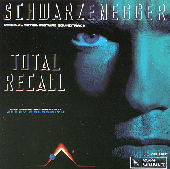Total
Recall
Music composed,
conducted and produced by JERRY GOLDSMITH - Performed by THE NATIONAL
PHILHARMONIC
ORCHESTRA - Varèse Sarabande VSD-5267, 1990 -Total duration: 40:35 |
Although
the story happens in a dystopian society, sometime in the XXIst century,
on two planets - Earth and Mars - and the leading actor being Arnold
Scharzenegger, and the genre action/adventure, it would have been very
tempting for the composer to use synthesizers. Instead Jerry Goldsmith
chose to use a traditional symphonic orchestra with some touches of synthesizer
sounds here and there, which is in fact a trademark of his style.
In my opinion, the most important
sequence in terms of music is the first chase when Quaid/Arnold S. is hunted
by the sinister Richter's thugs. (the Big Jump). In this chase which takes
place on earth J Goldsmith opted for a musical style which has its roots
in the music of Stravinsky and Bartok. The sounds palette is close to his
classic score for Patton. Brass: trombones and trumpets pets, and percussions,
mainly timpani and snare drums, are predominant.
Although this sequence is certainly scored to a click track (considering
the high number of 'hard' hit points and the tempo being very quick - around
144 bpm -) there is barely, a sense of a regular pulse, unlike ET where
the music has a far more flowing feel. This is because he barely
uses ostinati but instead utilizes/ and combines very short and brisk motives.
As a result the music sounds very aggressive, fragmented, even disjointed
and also very modern ( in a film music context) In my opinion, it is exactly
what the film needed.
Obviously it is also masterly done.
The sequence, which is very long starts when Quaid/Arnold Scharzenegger
has a very lively argument with his wife Lori/Sharon Stone as she learns
that he wants to go back to Mars! In fact, Lori, being a sort of domestic
secret agent, has the assignment to keep him under control. The music exactly
begins when we see. on the apartment television screen, some thugs coming
to help her. The motive we are hearing, four deep ominous brass chords
(ex. 1) is going to be used throughout the sequence with some variations
and is linked with Richter's gang of thugs. The whole sequence, which can
be divided in three parts, is going to last 8.01 m, that is to say until
Quaid arrives at the disused warehouse.
In the first part we have a second hard hit point when Quaid appears on
the stairs with a brisk and very high motive: a short upward chromatic
run followed by a jump played by the trumpets with a snare drum roll (ex.
2). Linked to Quaid this motive suggests perfectly his anxiety and his
struggle to escape. During the pursuit. when the tension increases, the
texture becomes thicker and the rhythm more accentuated through the use
of two other important motives first heard played by the low brass and
the cellos (ex. 3 and 4). The first part of this sequence ends when Quaid
escapes in a subway train at 3. 16. Dark brass chords stress the release
of tension.
Part two and three use the same musical elements. In fact, it is amazing
to realize how few musical elements there are to build up such a long and
dense sequence. It is ultimately the proof of the masterly craftsmanship
of Jerry Goldsmith.
May be the main title (The Dream)
is the weakest track on the album. But on the whole this an other Jerry
Goldsmith's masterly score.
One can only agree with Mark Walker*
about what he said about Jerry Goldsmith: "Nobody quite knows how, but
he continues to produce serious, original, top quality film music at a
prodigious rate".
*Mark Walker is the editor of the
Gramphone Film Music Good Cd Guide |